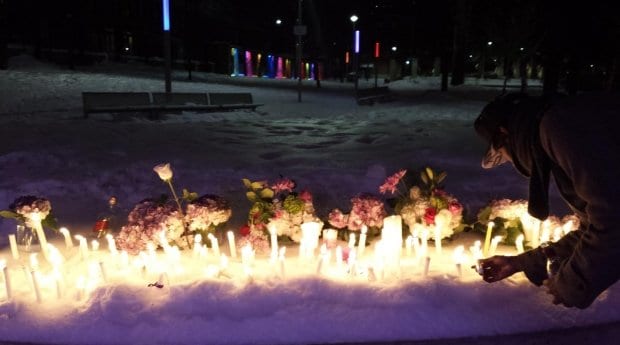
Credit: HG Watson
On a night when half of Toronto was plunged into a blackout, the lights burned bright at Barbara Hall Park and the 519 Church Street Community Centre, where friends, family and allies gathered to remember the life of Sumaya Dalmar.
While friends and family convened for an early evening private memorial for the 26-year-old trans woman in the ballroom on the second floor of The 519 on March 3, community members waited for a candlelight vigil to begin in the lobby, spilling out into the sidewalk when no more people could fit inside.
The atmosphere was subdued, but occasional laughter or shouts of recognition would break the silence as friends chatted or saw each other for the first time that night.
“She was so beautiful,” said one woman to her friends on the sidewalk outside. It was a sentiment that would be echoed over and over that evening — Dalmar was a beautiful woman, taken too soon.
Dalmar was the subject of rampant social media speculation — a Tumblr post, later taken down, gave rise to a rumour that she might have been murdered on Feb 22. But on Feb 24, a short Toronto police report was released on social media stating that there was no evidence that indicated the death of a woman in the east end of Toronto was suspicious.
When the story reached a wider audience, various outlets used photos taken from Dalmar’s social media accounts. Her friends remember her as a beautiful woman, both inside and out.
King, who works at Supporting our Youth (SOY), a community development project aimed at supporting LGBT youth, met Dalmar when she had come to participate in one of SOY’s programs. King explained that many of the people who participated in a support group for black, queer youth had become very close to Dalmar — King says many also became the main organizers of the memorial at The 519.
“There was a lot of love up there in that room,” King says.
Alicia, who declined to give their last name, knew Dalmar for a brief time after she became a community animator for the Toronto Community Housing Corporation (TCHC), as part of a project aimed at community revitalization within TCHC. Alicia didn’t have many words to say, but they remembered Dalmar as being very interested in the work.
Dalmar’s memorial took place where, if she were still alive, she would have been working. According to Lali Mohamed, a friend of Dalmar’s who helped organize the memorial, Dalmar was scheduled to start a new job at The 519 the Monday after she died. “A woman who had so much more life to live and so much possibility — life was snatched from her,” Mohamed says, recalling all the plans and ambitions that the 26-year-old had.
As the private memorial ended, the people gathered made their way down the stairs from The 519’s ballroom, taking white wax candles from a man passing them out, and headed out the doors towards Barbara Hall Park, where people had already begun lighting candles and setting them onto a raised garden bed.
While many were dressed in black, the attire of the crowd spoke to the diversity of people that Dalmar had connections with — rainbow bandanas or bowties poked out of jackets. Purple — considered by some to be a colour that represents trans people — was a common colour for people’s shirts and ties, matching the hydrangeas that decorated The 519’s ballroom.
Others, fashionably dressed, navigated the snowy terrain of the park in towering high heels. A few wore t-shirts that displayed a picture of Dalmar smiling.
“[She was] definitely one of a kind,” says TriShy, a friend who met Dalmar through a mutual acquaintance.
Her friend Shawtie Gotback, clad in a brightly patterned coat, remembered Dalmar as someone who broke down barriers. “With the gay community itself, everybody is segregated,” she says. “She was the one who would talk to anybody and that’s what I remember; that’s what I live for; that’s who I am, period. She was an amazing individual.”
But during the memorial, many of Dalmar’s friends were frustrated as they considered questions that remain about the last hours of Dalmar’s life. Close friends, including Mohamed, raised concerns that police have not done a thorough enough investigation into her death.
“That’s why it’s hard to grieve and mourn,” TriShy says. “A lot of people need some solid answers.”
Some trans activists, including Sophia Banks, have started investigating on their own, trying to find witnesses.
Maneesh Rampersad, who spoke to Daily Xtra before Dalmar’s memorial, claims to have seen a woman who looked like Dalmar running away from a man on Wellesley Street around 2:30 am on the night that she died. Rampersad reported what they saw to the Crime Stoppers hotline, but has not been contacted by the police.
Mohamed sees this not only as a pattern of police apathy toward investigating the deaths of trans women, but as indicative of a history of poor relations between Toronto’s police and the LGBT community. “There are so many deaths of trans women in this city whose deaths have gone unsolved and that is because, institutionally, Toronto Police Services does not give a fuck,” Mohamed says. “And this is an example of that.”
Standing outside of The 519, Monica Forrester, a trans and sex work activist, notes that the murder of Cassandra Do, a trans woman who was found strangled in her apartment in 2003, still remains unsolved.
“Sometimes marginalized communities aren’t getting the same kind of recognition other communities get when it comes to following up on what’s going on,” Forrester says.
The Trans Murder Monitoring Project found that 226 trans people were reported murdered in 2014 worldwide. This year, seven trans women — many of whom are trans women of colour — were murdered in the United States in almost as many weeks. This does not include unreported deaths, or deaths that were misreported because the victim was misgendered.
The Canadian Mental Health Association has also reported staggering statistics not only about the violence that trans people face, but the impact it has on their mental health. Over 77 percent of trans people who took part in an Ontario-based survey had seriously considered suicide, and 45 percent had attempted it. And as a whole, LGBT-identified people use alcohol and other substances more than heterosexual and cisgender people.
One woman, who declined to be identified, heard Dalmar’s story and felt compelled to come to the memorial service. Wiping away tears, she explained that she is the mother of a trans daughter. “[I] live in daily fear of something like this happening to her,” she says. She also thought of Dalmar’s mother, and hoped she knew that another mom knows how she feels.
Dalmar’s friends have fought to ensure that local media continues to tell her story. They want answers, but they also do not want her story to be wound into the narrative of the deaths of trans women of colour who are forgotten by the wider public.
Many who attended that night only knew Dalmar a little, if at all. Forrester noted her death reverberated through the African-Caribbean communities and communities-at-large.
“When another black life is taken, the entire community mourns,” Mohamed said. “Whether you know her or not.”
As the night grew darker, the crowd thinned. A party in Dalmar’s honour was planned at Buddies at Bad Times Theatre after the memorial, with proceeds going toward a benefit in Dalmar’s name. People started making plans to take taxis there, or meet others to have a drink before heading to the party.
Others lingered in the park by the candles — now numbering close to 100 — relighting the ones blown out by the wind.
HG Watson can be reached at hg.watson@dailyxtra.com or @hg_watson on Twitter.


 Why you can trust Xtra
Why you can trust Xtra


